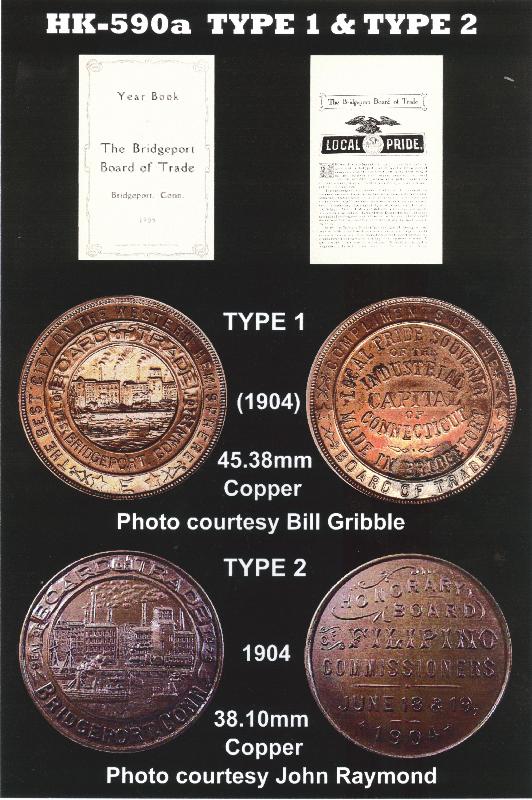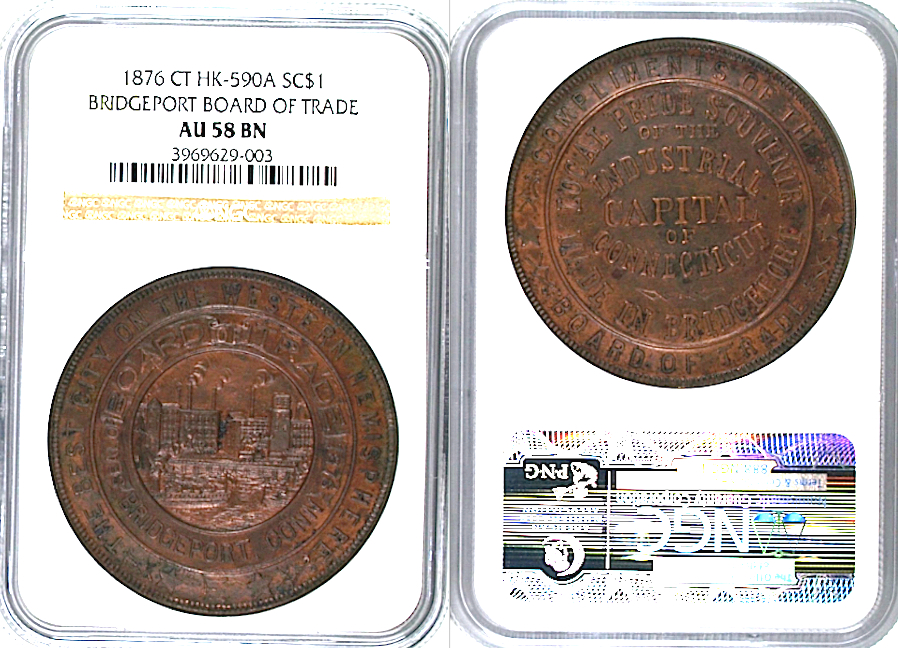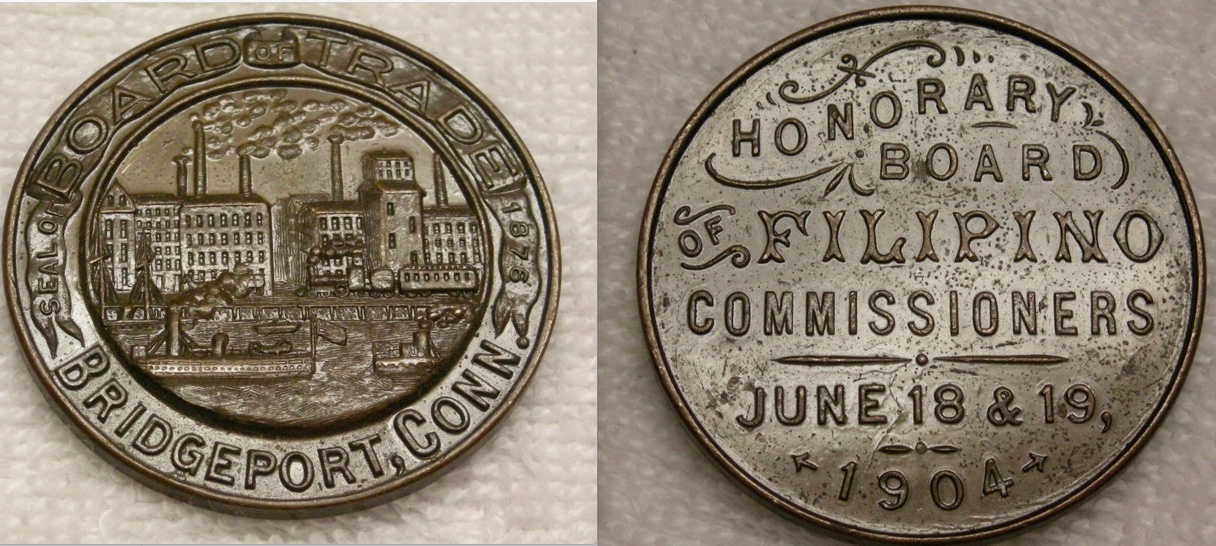So-Called Dollar Discussions
Bridgeport CT Board of Trade HK-590a
Quote from Pioneer on June 22, 2013, 6:47 pmA friend of mine owns an HK-590a, and I recently saw a similar (unlisted) so-called dollar with the same theme (Visiting Filipino Commissioners). This latter piece (38mm bronze) dates from 1904 and commemorates the visit of a Filipino Board to Bridgeport CT, one of three stops they made in New England during their visit. From what I have been told by a reliable source, the attribution of the HK-590 pieces is incorrect as they apparently date in 1904-1905 timeframe, not 1876. The HK-590 pieces appear to have followed the Filipino piece as a gift piece to visitors by the Bridgeport CT Board of Trade. Does anyone wish to post any more detailed research on these pieces?
A friend of mine owns an HK-590a, and I recently saw a similar (unlisted) so-called dollar with the same theme (Visiting Filipino Commissioners). This latter piece (38mm bronze) dates from 1904 and commemorates the visit of a Filipino Board to Bridgeport CT, one of three stops they made in New England during their visit. From what I have been told by a reliable source, the attribution of the HK-590 pieces is incorrect as they apparently date in 1904-1905 timeframe, not 1876. The HK-590 pieces appear to have followed the Filipino piece as a gift piece to visitors by the Bridgeport CT Board of Trade. Does anyone wish to post any more detailed research on these pieces?
Quote from bill on June 24, 2013, 2:15 pmHere's a silver piece (HK-12A). Not as pretty as some photoed here on Jeff's site, but like the ones i've seen in photos, no "BARBER" at the base of the neck, so presume this was made a little later in the 1800s, but it's still real of course. It has a little bit of the "pitted" feel in hand as Jeff mentioned.
I don't believe over the years that NGC even has any idea what is release year and what is restrike. I don't intend to put this one in my collection. Appears regardless of text that there are no barber signatures on any of these.
Here's a silver piece (HK-12A). Not as pretty as some photoed here on Jeff's site, but like the ones i've seen in photos, no "BARBER" at the base of the neck, so presume this was made a little later in the 1800s, but it's still real of course. It has a little bit of the "pitted" feel in hand as Jeff mentioned.
I don't believe over the years that NGC even has any idea what is release year and what is restrike. I don't intend to put this one in my collection. Appears regardless of text that there are no barber signatures on any of these.
Quote from billycgribble on June 25, 2013, 3:21 pmGood piece of research Billy, as always.
Good piece of research Billy, as always.
Quote from billycgribble on June 25, 2013, 4:33 pm1. This So Called Dollar was the result of the end of The Spanish American War. The Treaty of Paris 1898 ratified 1899 ceded Puerto Rico, parts of the West Indies, Guam and the Phillipines to the United States. 2. The Bridgeport Board of Trade celebrating its 25 year Anniversary in 1901 was tasked with coming up with a second 25 year plan. 3. The ceding of these countries set up military governors charged with running and developing these country's economies. The wealthy businessmen of Bridgeport along with the Board of Trade saw immense opportunity for business profit and personal wealth and decided on a massive business program to capitalize on the situation. 4.The crown jewel was the Philippines where a United States military government was set up August 14, 1898 and a joint U.S. military/civilian government July 1, 1901. 5. 1904 was a pivotal date because of the 1904 St. Louis World's Fair. The Bridgeport Board of Trade and wealthy businessmen devised a plan in 1903 to make themselves the major player in these developing economies. 6. The military governor and United States Congress decided to fund completely a massive Filipino Pavilion at the St Louis World's Fair, the travel of 50 leading Filipino businessmen to run it, (and later lead the Philippine economy) thereby showcasing Filipino products and training these 50 individuals in world economics. 7. The Bridgeport Board of Trade and businessmen successfuly lobbied the military and the U.S. Congress to pay to send these 50 businessmen to Bridgeport Conn enroute to the St. Louis World's Fair after arriving in San Francisco. This was to advance/train them in the world of economic trade agreements. 8. HK-590 was designed to kick off the campaign and help them lobby the military and Congress and get 100% 0f the local businessmen involved in the program. "The Best City on the Western Hemisphere" was to represent Bridgeport Board of Trade dominance in these ceded countries economic developement. "Local Pride" slogan represented jargon of the time relating to Made in U.S.A/Buy American. The central design was to show modern manufacturing buildings and clear deepwater harbor for shipping. 9. HK-590a was designed as presentation pieces to the 50 Filipino Commissioners as Honory Bridgeport Board of Trade members to attempt to align them to Bridgeport Conn and The Board of Trade for future trade agreements and profits as they developed their country and became Philippine leaders. Extremely rare due to low production numbers and most returning to the Philippines with the 50 individuals. 10. To kick off the campaign and get the pieces for the 50 delegation unit both of these SCD's were were most likely to have been struck at the same time by the same manufacturer due to the repeated uses of the obverses. 11. A lot of this information is contained in the 1905 Yearbook of The Bridgeport Board of Trade which started in 1903 to be published in 1904 but the finally published book was in 1905 causing the erroneous 1905 date and with the discovery of John Raymonds dated unlisted piece. For all you e readers and tablets advised about the 1.7 million free books available this is one of them. Available as read and PDF both. 12. The program was a huge success. In the 1890's Bridgeport had 48,866 people. In 1920 they had 143,555 people. The program met its objectives, created multiple hundreds of jobs and vast wealth. 13. I dont think Hibler and Kappen ever really saw this HK-590 piece or especially the supposed aluminum variety which has cost a lot of confusion. Seeing the listed white metal and copper HK-590a pieces I would make a guess that aluminum does not exist and is really a white metal piece which I've also never seen.
,
1. This So Called Dollar was the result of the end of The Spanish American War. The Treaty of Paris 1898 ratified 1899 ceded Puerto Rico, parts of the West Indies, Guam and the Phillipines to the United States. 2. The Bridgeport Board of Trade celebrating its 25 year Anniversary in 1901 was tasked with coming up with a second 25 year plan. 3. The ceding of these countries set up military governors charged with running and developing these country's economies. The wealthy businessmen of Bridgeport along with the Board of Trade saw immense opportunity for business profit and personal wealth and decided on a massive business program to capitalize on the situation. 4.The crown jewel was the Philippines where a United States military government was set up August 14, 1898 and a joint U.S. military/civilian government July 1, 1901. 5. 1904 was a pivotal date because of the 1904 St. Louis World's Fair. The Bridgeport Board of Trade and wealthy businessmen devised a plan in 1903 to make themselves the major player in these developing economies. 6. The military governor and United States Congress decided to fund completely a massive Filipino Pavilion at the St Louis World's Fair, the travel of 50 leading Filipino businessmen to run it, (and later lead the Philippine economy) thereby showcasing Filipino products and training these 50 individuals in world economics. 7. The Bridgeport Board of Trade and businessmen successfuly lobbied the military and the U.S. Congress to pay to send these 50 businessmen to Bridgeport Conn enroute to the St. Louis World's Fair after arriving in San Francisco. This was to advance/train them in the world of economic trade agreements. 8. HK-590 was designed to kick off the campaign and help them lobby the military and Congress and get 100% 0f the local businessmen involved in the program. "The Best City on the Western Hemisphere" was to represent Bridgeport Board of Trade dominance in these ceded countries economic developement. "Local Pride" slogan represented jargon of the time relating to Made in U.S.A/Buy American. The central design was to show modern manufacturing buildings and clear deepwater harbor for shipping. 9. HK-590a was designed as presentation pieces to the 50 Filipino Commissioners as Honory Bridgeport Board of Trade members to attempt to align them to Bridgeport Conn and The Board of Trade for future trade agreements and profits as they developed their country and became Philippine leaders. Extremely rare due to low production numbers and most returning to the Philippines with the 50 individuals. 10. To kick off the campaign and get the pieces for the 50 delegation unit both of these SCD's were were most likely to have been struck at the same time by the same manufacturer due to the repeated uses of the obverses. 11. A lot of this information is contained in the 1905 Yearbook of The Bridgeport Board of Trade which started in 1903 to be published in 1904 but the finally published book was in 1905 causing the erroneous 1905 date and with the discovery of John Raymonds dated unlisted piece. For all you e readers and tablets advised about the 1.7 million free books available this is one of them. Available as read and PDF both. 12. The program was a huge success. In the 1890's Bridgeport had 48,866 people. In 1920 they had 143,555 people. The program met its objectives, created multiple hundreds of jobs and vast wealth. 13. I dont think Hibler and Kappen ever really saw this HK-590 piece or especially the supposed aluminum variety which has cost a lot of confusion. Seeing the listed white metal and copper HK-590a pieces I would make a guess that aluminum does not exist and is really a white metal piece which I've also never seen.  ,
,
Quote from bill on June 27, 2013, 11:57 amI have not researched this piece. It is clear the 1876 is part of the seal of the Board of Trade and not the date of the medal. It would appear H&K made the assumption that the medal was made the year the BoT was founded? The Filipino piece has the BoT seal on one side, but that is all I see to connect the two. 590 may well be a 1905 piece or some other date. I agree, more research is needed.
I have not researched this piece. It is clear the 1876 is part of the seal of the Board of Trade and not the date of the medal. It would appear H&K made the assumption that the medal was made the year the BoT was founded? The Filipino piece has the BoT seal on one side, but that is all I see to connect the two. 590 may well be a 1905 piece or some other date. I agree, more research is needed.
Quote from billycgribble on July 6, 2013, 10:49 pmHere is the HK-590 next to the HK-590a photo
,
Here is the HK-590 next to the HK-590a photo ,
Quote from Pioneer on October 11, 2014, 5:11 pmHere's my piece from the recent Presidential Auction. It seems to be coated with some type of lacquer... and certainly could be bronze or copper as in your excellent research Bill G. Thanks for posting the info.
Here's my piece from the recent Presidential Auction. It seems to be coated with some type of lacquer... and certainly could be bronze or copper as in your excellent research Bill G. Thanks for posting the info.
Uploaded files:
